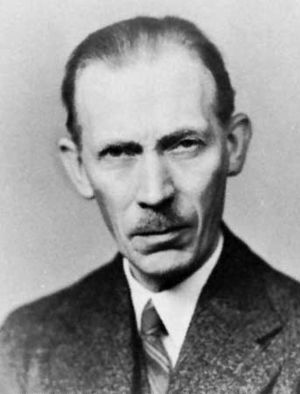Johannes Nicolaus Brønsted facts for kids
Quick facts for kids
Johannes Nicolaus Brønsted
|
|
|---|---|

Portrait of Johannes Brønsted
|
|
| Born | 22 February 1879 Varde, Denmark
|
| Died | 17 December 1947 (aged 68) |
| Nationality | Danish |
| Known for | Brønsted–Lowry acid–base theory Brønsted catalysis equation< Specific ion interaction theory |
| Awards | H. C. Ørsted Medal |
| Scientific career | |
| Fields | Physical chemistry |
| Institutions | University of Copenhagen |
Johannes Nicolaus Brønsted (22 February 1879 – 17 December 1947) was a brilliant Danish scientist. He was a physical chemist, which means he studied how matter behaves and changes. He is most famous for helping to create a very important idea in chemistry. It's called the Brønsted–Lowry acid–base theory. He developed this idea at the same time as another scientist, Martin Lowry.
Contents
A Scientist's Life
Early Life and Education
Johannes Brønsted was born in Varde, Denmark, on February 22, 1879. Sadly, his mother passed away soon after he was born. When he was 14, his father also died. Johannes then moved to Copenhagen with his older sister and his stepmother.
In 1897, Brønsted began studying to become a chemical engineer. He attended the Polytechnic Institute in Copenhagen. After getting his first degree, he decided to change his focus. In 1902, he earned a master's degree in chemistry from the University of Copenhagen.
Becoming a Professor
Brønsted became an assistant at the Chemical Institute in 1905. He then earned his doctoral degree in 1908. In the same year, he became a professor. He taught physical chemistry and inorganic chemistry at the University of Copenhagen.
Worldwide Recognition
In 1929, Brønsted was a visiting professor at Yale University in the United States. His scientific work became known all over the world. He was nominated for the Nobel Prize four times! He also received a gold H. C. Ørsted Medal. He was made a fellow of the Royal Society and a member of the National Academy of Sciences. These are very high honors for a scientist.
Family and Politics
Brønsted married Charlotte Warberg, whom he had met during his studies. They had four children together. During World War II, Brønsted was strongly against the Nazis. Because of his strong beliefs, he was elected to the Danish parliament in 1947. However, he was too ill to take his seat. He passed away shortly after the election.
Brønsted's Discoveries
Understanding Chemical Reactions
Early in his career, Brønsted studied chemical thermodynamics. This is about how heat and energy are involved in chemical changes. He also studied electrolyte solutions. These are liquids that can conduct electricity. He did many experiments to measure how much different substances could dissolve. His findings helped create general rules about how chemicals behave. These rules were later supported by the Debye–Hückel theory.
Acids and Bases
Brønsted is most famous for his work on reaction kinetics. This is the study of how fast chemical reactions happen. He was especially interested in acid–base reactions. In 1923, he realized something very important. He discovered that in acid-base reactions, a tiny particle called a proton moves. It moves from an acid (which gives away a proton) to a base (which accepts a proton).
At almost the same time, and without knowing about Brønsted's work, a British chemist named Martin Lowry came to the same conclusion. This is why the idea is called the Brønsted–Lowry acid–base theory. Also in 1923, another scientist, Gilbert N. Lewis, suggested a different theory about acids and bases based on electrons. Both theories are still used by chemists today!
Later Research
Later in his career, Brønsted continued to study how fast reactions happen. He focused on reactions that take place in liquids other than water, called non-aqueous solutions. He also studied how the size of molecules affects their properties. This included molecules found in hydrocarbons, polymers, and colloids. He even worked with George de Hevesy, a Nobel Prize winner. They worked together on separating different types of atoms, called isotope separation, using a method called fractional distillation.
See also
 In Spanish: Johannes Nicolaus Brønsted para niños
In Spanish: Johannes Nicolaus Brønsted para niños

